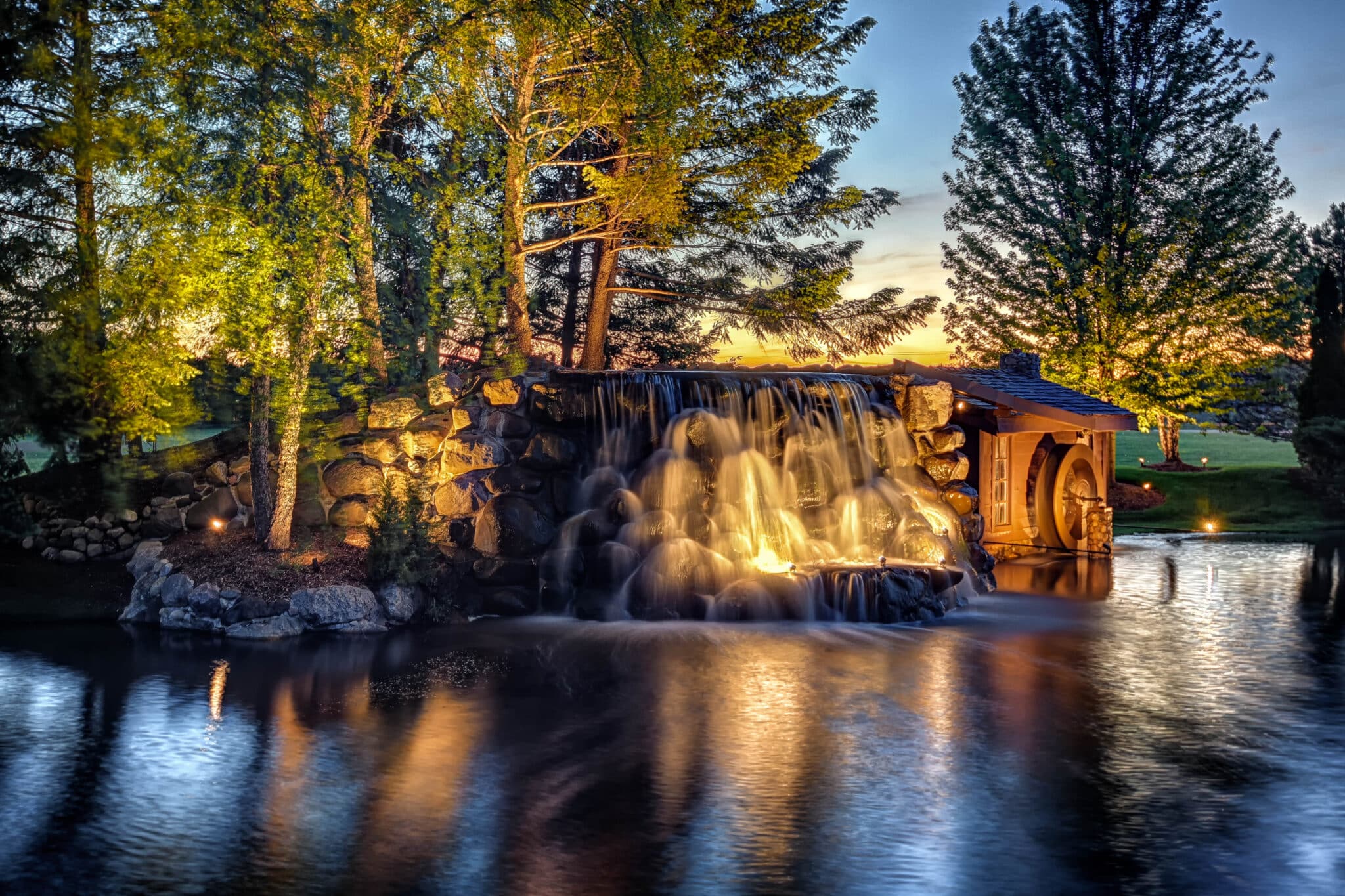Should I Light My Water Feature?
The answer is: yes! Adding light to a water feature provides a host of benefits beyond enhancing the aesthetics of your water feature. Lighting can improve the safety of the water feature itself, enhance its overall design and make other elements of the water feature stand out. If you’re looking to maximize the appeal of your water feature design, there are a variety of considerations that will influence how light is used around the water feature.
Why Should I Light My Water Feature?
Safety First
Water features look beautiful, but their design may create some inherent hazards. First, depending on the type of water feature you have, it could be a greater hazard for pets or children who are playing nearby. While waterfalls and fountains are usually less hazardous, flowing water or ponds may create greater hazards for those who accidentally trip, slip or fall into them. Likewise, paths and steps often run to or alongside water features, and they increase the likelihood of water being present on the path as well as the possibility of walking into the water feature makes lighting imperative. Fortunately, there are a variety of lighting options available for paths and steps to make your water feature safer. LED posts provide an exceptional amount of lighting with an efficient energy usage that provides lighting directly on paths. For steps, you can embed lighting into the step or have lighting run alongside the step, particularly if you have flowing water or a pond next to a retaining wall. A simple way to illuminate a fountain or waterfall to increase its visibility is to use a wash or up light directed onto the feature or slightly offset. This lighting style not only provides maximum illumination, but it also can provide a stark magnification of the flowing water at night.
Mood Matters
Aside from improving visibility, lighting water features also allows you to produce a certain mood. For example, different colored lights can be used to create a distinct optical effect. Changing the colors throughout the year allows the incorporation of festive themes into your lighting design. Depending on how your feature flows, you can use lighting alongside or, in the case of a waterfall, having lighting project from the vertical surface beneath the flow so that light comes from within the water, amplifying the optical effect. This method is often cheaper and more reliable than using underwater lighting, particularly since water naturally obscures light and makes it more diffuse. Lighting can also be embedded in rocks alongside a pond or steam feature that creates a unique, lifelike glow in or adjacent to the water that projects a magical, mysterious aura.
Enhance Other Features
Rarely are water features designed as standalone spectacles. Most often vegetation, permanent or semi-permanent structures (such as rocks/boulders or walls and perches) are incorporated into or nearby the design; even a bench by a pond can be incorporated into the design effect. Hence, when using light with water features, projecting the illumination towards these other features helps to enhance the design. For example, positioning lighting embedded beside water flowing from a horizontal fountain that projects onto vegetation can partially obscure the light, helping to soften its glow while creating a unique jungle mystique. If you have tall grass or cattails, You can use downlighting positioned in trees to illuminate lower vegetation that obscures light falling onto a stream or pond. A very popular method is to illuminate ponds, either with direct lighting from a downlight, a less intense overhead lighting such as bistro lighting or lampposts, or to use a horizontally projecting light that partially illuminates the pond. This is a great investment if you have fish or other aquatic life that comes alive at night.
Understanding the Power of Lighting
When using outdoor lighting around water features, it’s important to know how impactful it can be relative to the type of illumination you’re using and how it projects across the water’s surface. More often than not, using less lighting is more impressive than using abundant lighting, especially since water is a naturally reflective surface when light shines across it. That’s why it’s important to understand the angle of the lighting as a single light projecting across the water’s surface can have a much more dramatic effect than multiple lights shining toward it or even around it. Spotlighting and downlighting are popular in this regard as they can be positioned for maximum effect, especially when shone across a light surface such as a fountain or waterfall flowing into a pond. In this regard, uplighting is also a popular lighting source, particularly for fountains when projected from the base. Lighting, especially uplighting, can incorporate statues, benches, or other structures around the water feature for a more dramatic effect. It’s also important to take into consideration the type of lighting you wish to use. LED lighting and spotlighting can create intense lighting fields that are great for illumination but should be positioned so not to obscure anyone’s vision (which can cause them to fall into the water!). Halogen lights are another popular lighting style that can create a softer, warmer glow that is great for enhancing vegetation, as is incandescent light. These lighting styles might not last as long or be as energy efficient, a consideration depending on how you wish to design your water feature.
Light and Water: A Great Combination
Many overlook the importance of adding light around their water features. Many also assume that lighting needs to come from within a water feature, such as underwater lighting, to make a water feature stand out. Adding light provides a variety of important factors, including increasing safety, increasing the design of the water feature itself as well as enhancing surrounding design components. Lighting water features don’t need to be an elaborate affair, and a single light can have a dramatic effect on how your water feature stands out at night. If you’re looking to make the most out of your water feature and make it stand out at all hours of the day, we’d love to help you with the design and installation. Call (262) 358-9100 to schedule your design consultation!

